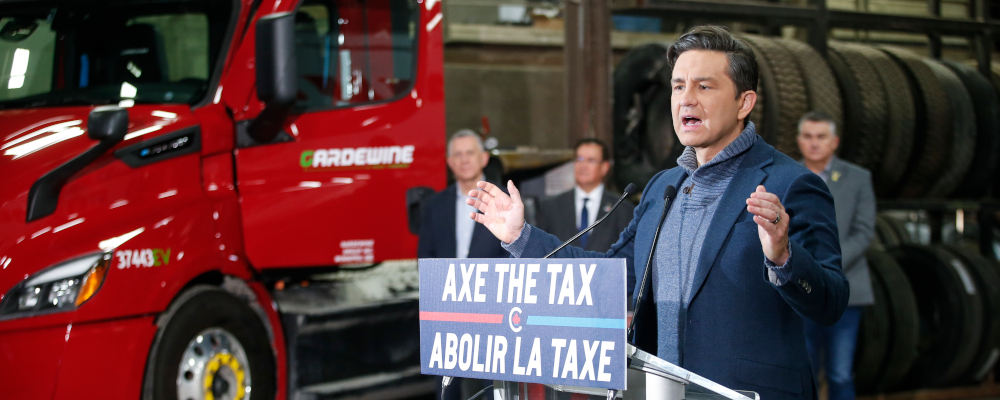Pierre Poilievre’s recent speech to the Greater Vancouver Board of Trade has received significant attention for its attack on lobbyists and the corporate class in Ottawa. But notwithstanding the subsequent commentary, it may not even be the most notable part of his remarks.
In the same breath, Poilievre proclaimed that, as prime minister, his “daily obsession will be about what is good for the working-class people of this country.” There’s a strong possibility that this vow is more consequential in terms of influencing a Poilievre-led government’s policy agenda and ultimately reshaping Canadian politics. It holds out the potential for a new multi-ethnic conservative coalition rooted in working-class values that could transform the country’s political landscape.
One of us will return to its possible political consequences in a subsequent commentary later this week. But any discussion of a working-class conservatism must begin with a clear understanding of who the working class actually is—where they live, what they do, how they came to join the working class, and what policies will help them flourish in the modern economy.
Canada’s modern working class is not necessarily who readers might think it is, according to research that we’ve conducted for the Cardus Institute. Using a common definition of the working class as the population of workers in jobs that typically don’t require postsecondary education, we found that there’s a big gap between the common stereotype—white, male, blue-collar workers in the auto sector or some other form of manufacturing employment—and today’s working-class experience.

The evolution of Canada’s working class
Here are some facts.
For most of recent history, women have actually composed more than half of the working class.
Over the last thirty years, manufacturing jobs have constituted a declining share of working-class employment. This is true even among men, for whom manufacturing employment went from a high of 20 percent of working-class jobs to only 13 percent today. Among women, manufacturing represents only 6 percent of working-class jobs.
Conversely, jobs in sales and services have grown significantly over the same time period. Today, almost half of the working class is employed in these jobs. Among working-class women, it’s more than half.
The trades continue to be an important part of working-class employment, but not as much as one might think. It’s mostly the helpers and labourers who fall into the working class, as opposed to those with formal training in a skilled trade. There’s also a huge difference between men and women in the trades. While 32 percent of working-class men are in trades-related work or employed as some other kind of transport and equipment operators, only 4 percent of working-class women are.
Immigrants are much more likely to find themselves in the working class than other Canadians. Census data show that the longer an immigrant has been in Canada, the less likely that he or she is a member of the working class. Fifty percent of immigrants who arrived in the previous five years found themselves in the working class, whereas only 34 percent—equivalent to the national average—of immigrants in Canada longer than 35 years did.
In short, the common stereotype of Canada’s working class no longer holds true. The “new working class,” as we called it in our paper, is just as likely to be female, much more likely to be working in a sales job or in the service industry, and highly likely to be recently immigrated.
These findings have important policy implications for the 6.5 million Canadians in working-class jobs. They constitute more than one-third of Canada’s workforce and represent the demographic foundation of a significant multi-ethnic, working-class voter coalition. But any party that seeks their votes must address their real policy needs.
A working-class policy agenda
On some of these issues, Conservatives have already staked out important territory. Take housing, for example. The transition from a goods-producing economy to a service-providing economy has led to an increasing concentration of the working class in major cities where services are most needed. Our research also predictably shows that the working class earns considerably less than other types of workers. The combination of these two factors makes it exceedingly difficult, if not impossible, for the working class to find affordable housing near where they work. The result is that working-class Canadians face impossible housing choices, including often longer commutes and less time with their families.
More efficient public transit will be a key part of the solution to this problem as well. Poilievre’s focus, as well as that of his predecessor Andrew Scheer, on housing densification along transit hubs is a good first step in that direction.
A working-class agenda must address foreign credential recognition for new immigrants. The time and income lost to immigrants before they can work in jobs that are commensurate with their education is a serious opportunity cost to both them and the Canadian economy. Poilievre’s commitment to establishing a 60-day guarantee for recognizing foreign credentials is promising for highly-skilled immigrants.

However, immigration policy must also recognize that low-skilled foreign workers may compete for the same kinds of jobs as working-class Canadians which can put downward pressure on wages. This represents an area within immigration policy that could pit a working-class agenda against the interests of businesses that rely on temporary foreign workers, but it is one that will require a response from a future government. A true working-class agenda would ostensibly cut the number of non-permanent residents entering the country and refocus the permanent resident stream so that it’s overwhelmingly high-skilled workers.
It would also significantly reform the Trudeau government’s childcare policy which fails to provide the flexibility needed by the working class. The current program prioritizes one kind of childcare: institutionalized daycare, which tends to offer childcare during standard 9-5 hours. But our research showed that the working class is more likely to be working unusual hours, including evenings and weekends, and is likely to hold more than one job. A working-class childcare agenda would be built around the needs of these families, which includes flexibility, something that the federal childcare program does not offer. One way to achieve this would be to put the money toward a reformed childcare expense deduction that would flow money directly to parents and leave the decision-making in their hands.
Finally, our education system needs a serious revamp. Consider for instance our research finding that 53 percent of those in working-class jobs have post-secondary credentials. This includes one in six who have a university degree. These numbers suggest a serious misalignment between our education system and the needs of the labour market.
While education mostly falls under provincial jurisdiction, the federal government subsidizes the system through the Canada Social Transfer and funds graduate and post-graduate research through the granting councils. A working-class agenda would aim to rebalance the focus of education policy to better reflect the interests of the 30 percent or so who consistently don’t go on to post-secondary education.
These are just a handful of policy areas that need to be fleshed out in a plan focused on the working class. The commonality is that they reflect the interests, needs, and aspirations of today’s working class based on how they actually live and work rather than commonly-held misperceptions.
These issues therefore represent a good test for Poilievre and the Conservatives and their genuine commitment to a new, working-class conservatism. Major policies on housing, immigration, childcare, and education would show that the Conservatives are attuned to changing working-class dynamics and ready to fulfill the vision of a multi-ethnic, working-class coalition for the twenty-first century.
Recommended for You

‘There needs to be new approaches to old ideas’: Why open debate is so important for shaping Israel’s future

Here’s how Canadian oil and gas can fuel global emissions reductions

Alberta’s health reforms draw on best practices from world-leading universal systems

Are Canadian immigration levels too high? Jason Kenney and Andrew Coyne debate



